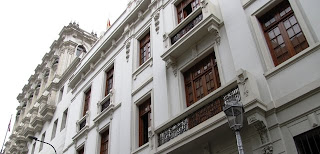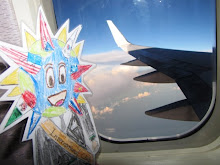I've been to Merida a couple of times before, but just for a day or two so I never really got to experience the city like I wanted. This time around, however, I'm really glad I got the chance to stay for a week because it's like I found a whole new side to Mexico that I had no idea existed. The architecture, food, plants and people are all different from anywhere else that I've been in this country.
A lot of the colonial architecture has been preserved which makes it really nice to just walk around and get lost on the quiet streets and tropical tree-lined boulevards.
Because it's hot hear year-round over here, guayabera shirst are really popular as well as other light clothing that just adds to the uniqueness of this part of Mexico. In fact, guayaberas are made here and shipped all over the world.
The food was different from anything I've tried elsewhere in Mexico. There's a dish called "cochinita pibil" which is pork marinated in an orange concentrate and served with a savory red chili pepper sauce and tortillas. Another delicious dish I ate was called "queso relleno" or stuffed cheese. Basically, it was a slice of a cheese roll stuffed with ground meat and spices in a bowl of a creamy flour sauce and tortillas. Besides these dishes, there was fresh seafood everywhere since Merida is right on the Gulf of Mexico. In fact, Merida is pretty much directly south across the Gulf from Bay St. Louis, Mississippi!
Besides the charming colonial mansions and food, right outside of Merida are several Mayan ruin sites-the most famous being Chichen Itza. Over the weekend, I met up with my 10th grade roommate from Stanislaus, Gerardo Gonzales, who lives here in Merida. Since I've already been to Chichen Itza, he took me to some ruins just 10 miles from Merida called Dzibilchaltún (tzee-BEEL-chal-toon). The major draw of this Mayan site is called the Temple of the Seven Dolls. This temple is situated so that every year, on the 21st of March and 22nd of September, the spring and fall equinox, the sun shines directly through the doorways as it rises.
Here are some more facts about Merida and some pictures of my time here:
- Mérida is the capital of the Mexican state of Yucatán.
- Yucatan peninsula is due South of New Orleans and Southwest of Miami.
- Founded January 6, 1542
- Founded by Francisco de Montejo
- Population: 1,658,210
- Climate: Tropical
- Industries: tourism, agriculture, fishing, construction and assemply plants
- Languages: Spanish and Maya
- Religion: 77% Catholic, some Presbyterians, Baptists, Jehovah's Witnesses and others
- Exports: Honey, sisal rope, petroleum products, hammocks, fine jewelry, concentrated orange juice, wood, squash seed, cement, lime, boats, leathers, vegetable coloring, fish, aloe vera, handcrafts and clothing
- Imports: Corn, sorghum, electronics, scrap metal, sisal

This is Gerardo. He was my 10th grade roommate at St. Stanislaus, and we've kept in touch ever since. He showed me around Merida and introduced me to a lot of schools and language centers so that I could promote St. Stanislaus to their students. Gerardo is starting up his own business in Merida and comes to visit St. Stanislaus every now and then.

This is the temple where the sun shines through the doorways every spring and fall equinox. Mayans were very advanced in astronomy and this building is a centuries-old testament to their knowledge.




























































